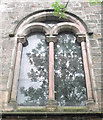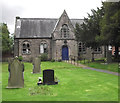1
Buxton Road at Havannah Lane
Image: © Colin Pyle
Taken: 22 Mar 2014
0.05 miles
2
Buglawton Bear
Image: © Brian Deegan
Taken: 27 Aug 2016
0.07 miles
3
St John's Church, Buglawton- Neglected corner
Having walked through a very well kept churchyard (
Image), it was very strange to come across this untouched corner. Perhaps it is being kept as a wildlife section?
Image: © Jonathan Kington
Taken: 29 Aug 2011
0.21 miles
4
St John's Church, Buglawton- Northern window
Hidden at the back of the church and mimicking the larger one to the front (
Image), is this lovely two-light arched and mullioned window with a third tympanum light and hood mould above. Both the mullion and jambs are designed to look like columns that rise from a single piece stooled sill, the three capitals supporting the two arched transoms below the tympanum are carved to resemble Norman period architecture.
Image: © Jonathan Kington
Taken: 29 Aug 2011
0.21 miles
5
St John's Church, Buglawton- West elevation
Looking at the west elevation of the church from
Image
St John’s, or St John the Evangelist’s, Church was the first of several new churches to be built in the borough of Congleton, originally as a ‘district church’ within the Parish of Astbury. The church was built on land gifted by a Mr Thomas Chapman of the Lowe after being petitioned by the first Vicar of Buglawton, the Reverend Edward Wilson. It was built in the pseudo-Norman style and cost £2,286; the money was raised by voluntary public subscription and a grant from the Diocesan Church Building Society. St John’s was consecrated on the 13th October 1840, the procession consisting of the Bishop and the Town Corporation was preceded by a group of Chartists and Socialists carrying a black flag and the Death’s Head and crossed bones!
Historical information from The History of Congleton by W. B. Stephens, Congleton History Society: page 219 ( http://tinyurl.com/43cevt6 ).
Image: © Jonathan Kington
Taken: 29 Aug 2011
0.22 miles
6
St John's Church, Buglawton- Tower door
This door at the base of the tower, according to The History of Congleton by W. B. Stephens, leads to the choir and organ gallery.
St John’s, or St John the Evangelist’s, Church was the first of several new churches to be built in the borough of Congleton, originally as a ‘district church’ within the Parish of Astbury. The church was built on land gifted by a Mr Thomas Chapman of the Lowe after being petitioned by the first Vicar of Buglawton, the Reverend Edward Wilson. It was built in the pseudo-Norman style and cost £2,286; the money was raised by voluntary public subscription and a grant from the Diocesan Church Building Society. St John’s was consecrated on the 13th October 1840, the procession consisting of the Bishop and the Town Corporation was preceded by a group of Chartists and Socialists carrying a black flag and the Death’s Head and crossed bones!
Historical information from The History of Congleton by W. B. Stephens, Congleton History Society: page 219 ( http://tinyurl.com/43cevt6 ).
Image: © Jonathan Kington
Taken: 29 Aug 2011
0.22 miles
7
St John's Church, Buglawton- Southern and Eastern clockfaces
Two of three clocks on the tower, all of which have stopped at different times. See also
Image
Image: © Jonathan Kington
Taken: 29 Aug 2011
0.22 miles
8
St John's Church, Buglawton- South and East elevations
Taken from the south-east corner of the churchyard, for a comparison see Francis Frith's picture taken in 1898: http://www.francisfrith.com/congleton/photos/st-johns-church-buglawton-1898_42170/ . The trees have grown and the ivy has been removed from the walls, but very little has changed.
St John’s, or St John the Evangelist’s, Church was the first of several new churches to be built in the borough of Congleton, originally as a ‘district church’ within the Parish of Astbury. The church was built on land gifted by a Mr Thomas Chapman of the Lowe after being petitioned by the first Vicar of Buglawton, the Reverend Edward Wilson. It was built in the pseudo-Norman style and cost £2,286; the money was raised by voluntary public subscription and a grant from the Diocesan Church Building Society. St John’s was consecrated on the 13th October 1840, the procession consisting of the Bishop and the Town Corporation was preceded by a group of Chartists and Socialists carrying a black flag and the Death’s Head and crossed bones!
Historical information from The History of Congleton by W. B. Stephens, Congleton History Society: page 219 ( http://tinyurl.com/43cevt6 ).
Image: © Jonathan Kington
Taken: 29 Aug 2011
0.22 miles
9
The old St John's School
A Grade II listed ( http://www.britishlistedbuildings.co.uk/en-55856-st-johns-school-congleton ) former National Day and Sunday School built in 1843 (
Image), three years after the adjacent church. There is also a school house behind the school building that can be seen in
Image
Image: © Jonathan Kington
Taken: 29 Aug 2011
0.22 miles
10
St John's Church, Buglawton- Weather vane
The weather vane is on the steeple on St John's Church.
For centuries weathervanes, or weathercocks, have kept people in touch with the elements, signalling those shifts in the wind, which bring changes in the weather. Nowadays they are typically used as an architectural ornament at the highest point of a building. Although the cockerel is the traditional design, ships, arrows, pheasants, people and horses to name but a few are also common. Weathervanes are designed in such a way that the weight is evenly distributed on each side of the surface, but the surface area is unequally divided, so that the pointer can move freely on its axis. The side with the larger surface area is blown away from the wind direction, so that the smaller side, with the pointer, turns to face the wind direction. Most vanes have pointers below that are aligned with the compass points, north, east, south and west. Because of a papal edict in the 9th century there were a great number of weathercocks to be found on churches, the edict ordered that every Church in Christendom had to be mounted with a cockerel to symbolise Peter’s betrayal of Christ (Luke 22:34- "I tell thee, Peter, the cock shall not crow this day, before that thou shalt thrice deny that thou knowest me"). Although the edict only required the cockerel to be a symbol it soon became a weathervane and by the 13th century both terms, weathercock and weathervane, were being used interchangeably. Because Christian churches are always laid out east to west early weathercocks did not need to have compass directions attached to them, although it could be a bit tricky with this church being laid NNE to SSW.
Image: © Jonathan Kington
Taken: 29 Aug 2011
0.22 miles











